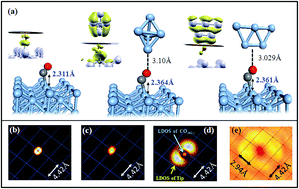A nano Ag5 cluster tip probing the vertical transfer of CO(ads) adsorbed on Ag(110) with simulated inelastic electron tunneling spectroscopy
Abstract
A nano Ag5 cluster tip probing the vertical transfer of CO(ads) adsorbed on a Ag(110) surface has been investigated with simulated inelastic electron tunneling spectroscopy (IETS) generated by combining DFT-based molecular dynamic simulations with a Fourier transform of auto-correlation function of the derivative of local density of states (FT-ACF-δLDOS). It is found that tunneling conductance generated based on the trajectories of LDOS is significantly increased as a nano Ag5 cluster tip is introduced and their vibrational amplitudes of low-frequency modes are enhanced in IETS. In addition, the IETS shows the doublet feature in the regions of low-frequency mode, i.e. frustrated-rotation, and high-frequency mode, i.e. C–O stretching, respectively, due to the change of geometry of CO(ads) leading to the transfer of CO(ads) adsorbed on the Ag(110) surface to a nano Ag5 cluster tip. Furthermore, an anharmonic coupling between frustrated-rotation and C–O stretching mode is investigated by using time-resolved IETS analysis. Finally, the key issue regarding the activation of low-frequency modes by a nano Ag5 cluster tip to cause the transfer of CO(ads) adsorbed on Ag(110) surface is addressed.



 Please wait while we load your content...
Please wait while we load your content...